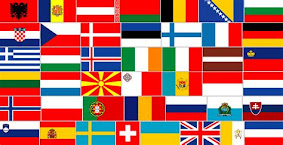The Semantics of Dyed Blue Hair
in the Modern West
"For who can denie but it repugneth to nature, that the blind shal be appointed to leade and conduct such as do see? That the weake, the sicke, and impotent persones shall norishe and kepe the hole and strong, and finallie, that the foolishe, madde and phrenetike shal gouerne the discrete, and giue counsel to such as be sober of mind?" John Knox
I could not resist re-purposing the title of John Knox's 16th-century diatribe against female rulers for another contemporary issue, but actually there have already been quite a few toots on the horn against the legions of blue-haired harpies that seem to be a fixture on the SJW Left. In 2015, a rather good article at Breitbart came up with the word "aposematism" to explain the phenomenon:
Nature has a name for wielding unusual colour as a warning sign: aposematism, from the Greek 'away' and 'sign.' And blue is one of the most unnatural colours of them all. In nature, there are no blue foods, so consequently we have no natural appetite for it. Even blue cheese is white cheese with mould on. Early man knew to avoid the blue poison dart frog. Modern man knows the same is true of a Canadian gender studies student who thinks she’s Zelda.
"Girls just wannabe shunned," to paraphrase Cyndi Lauper. A clever but rather shallow analysis that doesn't really get at what's going on here.
To see this, first we have to consider the blue-haired phenomenon in the wider context of hair care. Normal people dye their hair natural colours to appear younger or sometimes Whiter or more Nordic. This, of course, makes sense, because, even though it is duplicitous, it is still an invocation of nature, and one with benefits, because being seen as younger, Whiter, or more Nordic is an advantage.
 |
| White cheese with mould on? |
The same cannot be said for blue-hair or other clearly unnatural and artificial colours. They are operating on an entirely different dynamic. In fact, by dying their hair blue (or occasionally other unnatural colours) they are essentially invoking an idea of unnaturalness—or, more precisely, seeking to dismiss nature. This makes blue-hair dying radically different from, say, someone like the Mulatto pop star Beyonce, who both straightens her hair and lightens it in an attempt to counterbalance her high T-count and appear more "feminine."
Typically the blue hair dyer is—or starts as—a person of teenage years who is going through a confused "phase," sometimes with an element of gender confusion. They may be lesbians, queers, or transgender people, but not necessarily so.
This element of being low-cost, of a sacrifice given that isn't really a sacrifice, totally fits the psychological dynamic of the Left. Anything Leftist—from thought to fashion to morality—shares this characteristic of carrying as little personal cost as possible.
The fundamental utility of leftism is that one can dress like a slob and claim to be "fashionable," espouse thoughtless opinions and claim to be an "intellectual," and morally signal while being a complete degenerate. This also makes it a low-threshold system of easy access, which is why it has traditionally appealed to the young, the immature, and the untalented.
While the dull leftist plays at being a freak to appear "interesting," let us consider the true freak, the real McCoy. For example, having a confused sexual identity presents the subject with a number of options, some authentic, some inauthentic.
 |
| Leftism: low threshold |
This might seem like a form of denial and thus inauthentic. But the struggle is hard. The suffering and the pain involved, and of course the hard-won rewards—acceptance and the knowledge that one is supporting a healthy, non-degenerate society—give this form of "denial" a truly genuine character.
The polar opposite of this—entirely embracing one's gender confusion—also partakes of authenticity, even though the subject is placed in a "false position" vis-a-vis the society that is incapable of truly accepting him or her. This falseness is because any society, even one that ostensibly espouses "tolerance" as an ideology, will still be inherently opposed to transgenderism simply because the vast majority of its people will remain cis-gendered "normies."
Embracing one's gender confusion exerts a small cost on the broader society, but the costs on the individual level are extremely high, because the logic of doing so leads one into a battle against one's own given biology. These costs run the gamut from extreme grooming and radical fashions to intrusive and destructive sexual acts, and on from there to hormone replacement and full-blown surgical alteration, something that often carries disastrous psychological costs and can lead to suicide.
The high costs—the suffering in genuine blood and tears—involved in this path are once again a measure of its authenticity.
In this respect, neither of these courses are essentially Left-wing. The steely "will to cisgenderism" of the disciplinarian denier is grim, puritanical, and fascistic; while the drag queen diva or radical body modifier has an element of god-like, transhumanist will-to-be that riffs against a sense of deep tragedy. This too is also closer to a right-wing spirit than a left-wing one.
This leads us back to the blue-haired brigade, who may often have a half-hearted piercing or two. They are the cowardly lukewarm water of freakery—genderwise or otherwise—between the fire and ice of the more authentic forms of flagrant freakery or dark self-discipline.
Needless to say, the blue-haired entity rejects any sense of discipline. After all, its natural habitat is the undemanding life of college with its safe spaces and low workload, or else affirmative action feminist hireling. But, while it wishes to reject discipline and nature, it wishes to do so in the easiest and mildest manner possible. Blue hair—a cheap, unnatural colour that places few technical demands on most hair—is the lowest threshold to freakhood, and the one with the lowest costs. You can be a freak without even trying and without consequences—the sweet spot of the Leftist.



























